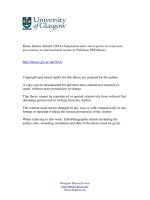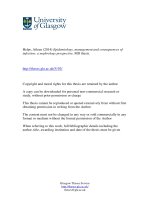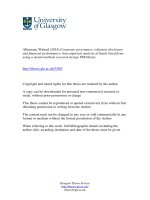FM11 Ch 15 Corporate Valuation, Value-Based Management, and Corporate Governance
Bạn đang xem bản rút gọn của tài liệu. Xem và tải ngay bản đầy đủ của tài liệu tại đây (134.37 KB, 45 trang )
15 - 1
CHAPTER 15
Corporate Valuation, Value-Based
Management, and Corporate
Governance
Corporate Valuation
Value-Based Management
Corporate Governance
15 - 2
Corporate Valuation:
List the two types of assets that a
company owns.
Assets-in-place
Financial, or nonoperating,
assets
15 - 3
Assets-in-Place
Assets-in-place are tangible, such as
buildings, machines, inventory.
Usually they are expected to grow.
They generate free cash flows.
The PV of their expected future free
cash flows, discounted at the WACC,
is the value of operations.
15 - 4
Value of Operations
∑
∞
=
+
=
1t
t
t
Op
)WACC1(
FCF
V
15 - 5
Nonoperating Assets
Marketable securities
Ownership of non-controlling
interest in another company
Value of nonoperating assets usually
is very close to figure that is
reported on balance sheets.
15 - 6
Total Corporate Value
Total corporate value is sum of:
Value of operations
Value of nonoperating assets
15 - 7
Claims on Corporate Value
Debtholders have first claim.
Preferred stockholders have the next
claim.
Any remaining value belongs to
stockholders.
15 - 8
Applying the Corporate Valuation
Model
Forecast the financial statements, as
shown in Chapter 14.
Calculate the projected free cash flows.
Model can be applied to a company
that does not pay dividends, a privately
held company, or a division of a
company, since FCF can be calculated
for each of these situations.
15 - 9
Data for Valuation
FCF
0
= $20 million
WACC = 10%
g = 5%
Marketable securities = $100 million
Debt = $200 million
Preferred stock = $50 million
Book value of equity = $210 million
15 - 10
Value of Operations:
Constant Growth
Suppose FCF grows at constant rate g.
( )
( )
∑
∑
∞
=
∞
=
+
+
=
+
=
1t
t
t
0
1t
t
t
Op
WACC1
)g1(FCF
WACC1
FCF
V
15 - 11
Constant Growth Formula
Notice that the term in parentheses
is less than one and gets smaller as t
gets larger. As t gets very large,
term approaches zero.
∑
∞
=
+
+
=
1t
t
0Op
WACC1
g1
FCFV
15 - 12
Constant Growth Formula (Cont.)
The summation can be replaced by a
single formula:
( )
( )
gWACC
)g1(FCF
gWACC
FCF
V
0
1
Op
−
+
=
−
=
15 - 13
Find Value of Operations
( )
( )
420
05.010.0
)05.01(20
V
gWACC
)g1(FCF
V
Op
0
Op
=
−
+
=
−
+
=
15 - 14
Value of Equity
Sources of Corporate Value
Value of operations = $420
Value of non-operating assets = $100
Claims on Corporate Value
Value of Debt = $200
Value of Preferred Stock = $50
Value of Equity = ?
15 - 15
Value of Equity
Total corporate value = V
Op
+ Mkt. Sec.
= $420 + $100
= $520 million
Value of equity = Total - Debt - Pref.
= $520 - $200 - $50
= $270 million
15 - 16
Market Value Added (MVA)
MVA = Total corporate value of firm
minus total book value of firm
Total book value of firm = book value
of equity + book value of debt + book
value of preferred stock
MVA = $520 - ($210 + $200 + $50)
= $60 million
15 - 17
Breakdown of Corporate Value
0
100
200
300
400
500
600
Sources
of Value
Claims
on Value
Market
vs. Book
MVA
Book equity
Equity (Market)
Preferred stock
Debt
Marketable
securities
Value of operations
15 - 18
Expansion Plan: Nonconstant Growth
Finance expansion by borrowing $40
million and halting dividends.
Projected free cash flows (FCF):
Year 1 FCF = -$5 million.
Year 2 FCF = $10 million.
Year 3 FCF = $20 million
FCF grows at constant rate of 6%
after year 3.
(More…)
15 - 19
The weighted average cost of capital,
r
c
, is 10%.
The company has 10 million shares
of stock.
15 - 20
Horizon Value
Free cash flows are forecast for three
years in this example, so the forecast
horizon is three years.
Growth in free cash flows is not
constant during the forecast,so we
can’t use the constant growth
formula to find the value of
operations at time 0.
15 - 21
Horizon Value (Cont.)
Growth is constant after the horizon
(3 years), so we can modify the
constant growth formula to find the
value of all free cash flows beyond
the horizon, discounted back to the
horizon.
15 - 22
Horizon Value Formula
Horizon value is also called terminal
value, or continuing value.
( )
gWACC
)g1(FCF
VHV
t
ttimeatOp
−
+
==
15 - 23
V
op
at 3
Find the value of operations by discounting
the free cash flows at the cost of capital.
0
-4.545
8.264
15.026
398.197
1 2 3 4
r
c
=10%
416.942 = V
op
g = 6%
FCF= -5.00 10.00 20.00 21.2
$21.2
. .
$530.
10 0 06
=
−
=
0
15 - 24
Find the price per share of common
stock.
Value of equity = Value of operations
- Value of debt
= $416.94 - $40
= $376.94 million.
Price per share = $376.94 /10 = $37.69.
15 - 25
Value-Based Management (VBM)
VBM is the systematic application
of the corporate valuation model
to all corporate decisions and
strategic initiatives.
The objective of VBM is to
increase Market Value Added
(MVA)







![brown and calor - 2004 - the correlation between corporate governance and company performance [cgs-fp]](https://media.store123doc.com/images/document/2015_01/02/medium_izzlTXr0MM.jpg)
![brown, caylor - 2006 - corporate governance and firm performance [cgs-gov-score]](https://media.store123doc.com/images/document/2015_01/02/medium_odt1420194779.jpg)
![gompers et al - 2003 - corporate governance and equity prices [cgi-g-index]](https://media.store123doc.com/images/document/2015_01/02/medium_qgt1420194792.jpg)